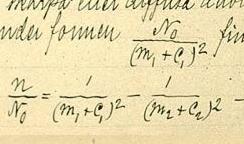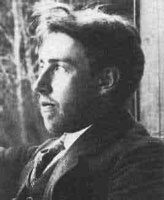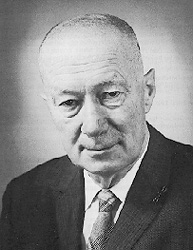Related Research Articles

Aage Niels Bohr was a Danish nuclear physicist who shared the Nobel Prize in Physics in 1975 with Ben Mottelson and James Rainwater "for the discovery of the connection between collective motion and particle motion in atomic nuclei and the development of the theory of the structure of the atomic nucleus based on this connection". Starting from Rainwater's concept of an irregular-shaped liquid drop model of the nucleus, Bohr and Mottelson developed a detailed theory that was in close agreement with experiments. Since his father, Niels Bohr, had won the prize in 1922, he and his father were one of the six pairs of fathers and sons who have both won the Nobel Prize and one of the four pairs who have both won the Nobel Prize in Physics.

In atomic physics, the Bohr model or Rutherford–Bohr model, presented by Niels Bohr and Ernest Rutherford in 1913, is a system consisting of a small, dense nucleus surrounded by orbiting electrons—similar to the structure of the Solar System, but with attraction provided by electrostatic forces in place of gravity. After the cubical model (1902), the plum pudding model (1904), the Saturnian model (1904), and the Rutherford model (1911) came the Rutherford–Bohr model or just Bohr model for short (1913). The improvement over the 1911 Rutherford model mainly concerned the new quantum physical interpretation.

Niels Henrik David Bohr was a Danish physicist who made foundational contributions to understanding atomic structure and quantum theory, for which he received the Nobel Prize in Physics in 1922. Bohr was also a philosopher and a promoter of scientific research.

The Niels Bohr Institute is a research institute of the University of Copenhagen. The research of the institute spans astronomy, geophysics, nanotechnology, particle physics, quantum mechanics and biophysics.

In atomic physics, the Rydberg formula calculates the wavelengths of a spectral line in many chemical elements. The formula was primarily presented as a generalization of the Balmer series for all atomic electron transitions of hydrogen. It was first empirically stated in 1888 by the Swedish physicist Johannes Rydberg, then theoretically by Niels Bohr in 1913, who used a primitive form of quantum mechanics. The formula directly generalizes the equations used to calculate the wavelengths of the hydrogen spectral series.

The Franck–Hertz experiment was the first electrical measurement to clearly show the quantum nature of atoms, and thus "transformed our understanding of the world". It was presented on April 24, 1914, to the German Physical Society in a paper by James Franck and Gustav Hertz. Franck and Hertz had designed a vacuum tube for studying energetic electrons that flew through a thin vapor of mercury atoms. They discovered that, when an electron collided with a mercury atom, it could lose only a specific quantity of its kinetic energy before flying away. This energy loss corresponds to decelerating the electron from a speed of about 1.3 million meters per second to zero. A faster electron does not decelerate completely after a collision, but loses precisely the same amount of its kinetic energy. Slower electrons merely bounce off mercury atoms without losing any significant speed or kinetic energy.

Harald August Bohr was a Danish mathematician and footballer. After receiving his doctorate in 1910, Bohr became an eminent mathematician, founding the field of almost periodic functions. His brother was the Nobel Prize-winning physicist Niels Bohr. He was a member of the Danish national football team for the 1908 Summer Olympics, where he won a silver medal.
In mathematics, a characterization of an object is a set of conditions that, while different from the definition of the object, is logically equivalent to it. To say that "Property P characterizes object X" is to say that not only does X have property P, but that X is the only thing that has property P. Similarly, a set of properties P is said to characterize X, when these properties distinguish X from all other objects. Even though a characterization identifies an object in a unique way, several characterizations can exist for a single object. Common mathematical expressions for a characterization of X in terms of P include "P is necessary and sufficient for X", and "X holds if and only if P".
In mathematical analysis, the Bohr–Mollerup theorem is a theorem proved by the Danish mathematicians Harald Bohr and Johannes Mollerup. The theorem characterizes the gamma function, defined for x > 0 by
In physics, complementarity is a conceptual aspect of quantum mechanics that Niels Bohr regarded as an essential feature of the theory. The complementarity principle holds that objects have certain pairs of complementary properties which cannot all be observed or measured simultaneously. An example of such a pair is position and momentum. Bohr considered one of the foundational truths of quantum mechanics to be the fact that setting up an experiment to measure one quantity of a pair, for instance the position of an electron, excludes the possibility of measuring the other, yet understanding both experiments is necessary to characterize the object under study. In Bohr's view, the behavior of atomic and subatomic objects cannot be separated from the measuring instruments that create the context in which the measured objects behave. Consequently, there is no "single picture" that unifies the results obtained in these different experimental contexts, and only the "totality of the phenomena" together can provide a completely informative description.

Assistens Cemetery in Copenhagen, Denmark, is the burial site of many Danish notables as well as an important greenspace in the Nørrebro district. Inaugurated in 1760, it was originally a burial site for the poor laid out to relieve the crowded graveyards inside the walled city, but during the Golden Age in the first half of the 19th century it became fashionable and many leading figures of the epoch, such as Hans Christian Andersen, Søren Kierkegaard, Christoffer Wilhelm Eckersberg, and Christen Købke are all buried here.

Johannes (Jan) Martinus Burgers was a Dutch physicist and the brother of the physicist Wilhelm G. Burgers. Burgers studied in Leiden under Paul Ehrenfest, where he obtained his PhD in 1918. He is credited to be the father of Burgers' equation, the Burgers vector in dislocation theory and the Burgers material in viscoelasticity.
The Danish Mathematical Society is a society of Danish mathematicians founded in 1873 at the University of Copenhagen, a year after the French Mathematical Society. According to the society website, it has "the purpose of acting for the benefit of mathematics in research and education."
Events from the year 1922 in Denmark.

Gustav Bartholin Hagen was a Danish architect. He was the father of the architect Ole Hagen (1913-1984).

Per Mollerup is a Danish designer, academic, and author. He is known for his emphasis on simplicity in design and for his wayshowing design at airports in Copenhagen, Oslo, and Stockholm, as well as the Copenhagen Metro. He is currently a Professor of Communication Design at Swinburne University of Technology's School of Design.
Asta Malthea Mollerup was a Danish dance teacher who was one of the first to introduce the Danes to modern dance, a new trend which was inspired by the American dancer Isadora Duncan and the German choreographer Mary Wigman. From 1914, she ran her own dancing school for children in Copenhagen and in 1927 she founded the Asta Mollerup School for Female Dancers. Apart from the Royal Danish Academy of Music, it was Denmark's only dancing school.
Mollerup is a surname. Notable people with the surname include:
In mathematics, the Wielandt theorem characterizes the gamma function, defined for all complex numbers for which by
References
- ↑ "Forfattere, litteraturpriser mv". August 2021.
- ↑ Johannes Mollerup. Gyldendal – Den Store Danske.